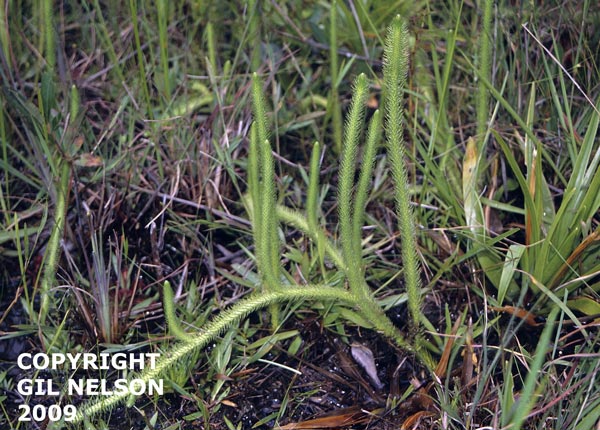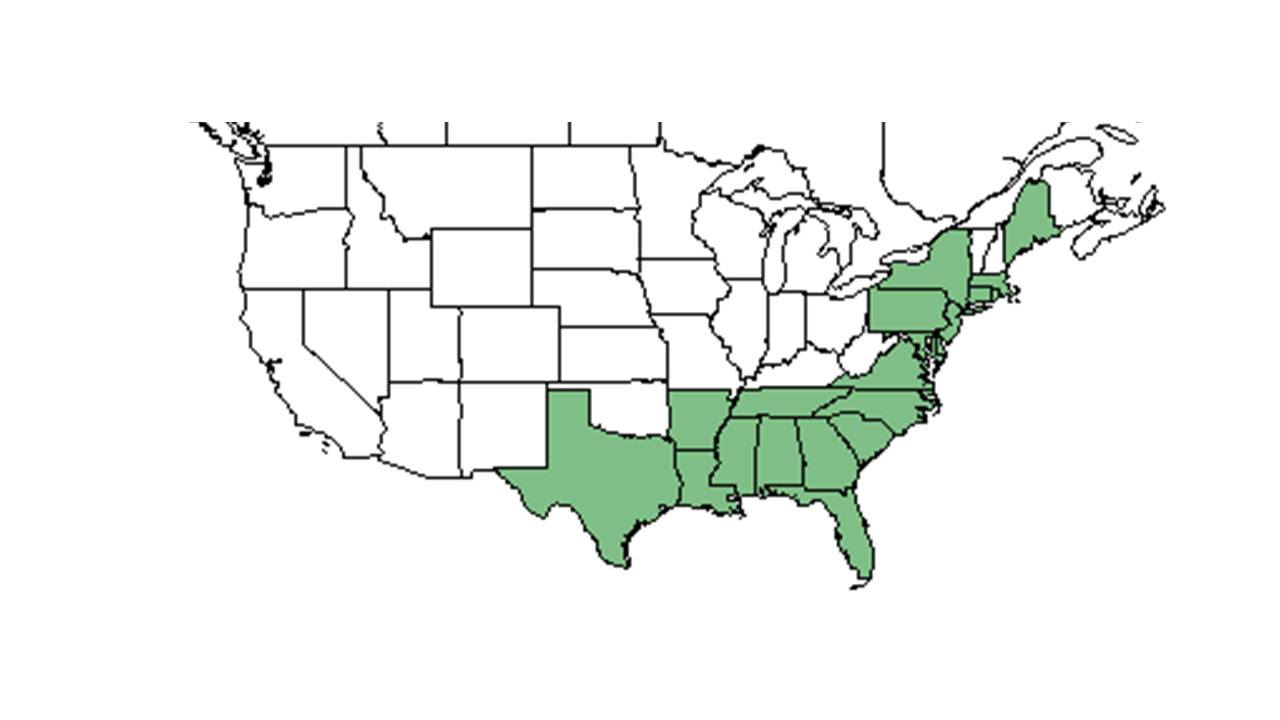Difference between revisions of "Lycopodiella alopecuroides"
KatieMccoy (talk | contribs) |
|||
| Line 29: | Line 29: | ||
==Ecology== | ==Ecology== | ||
===Habitat=== <!--Natural communities, human disturbed habitats, topography, hydrology, soils, light, fire regime requirements for removal of competition, etc.--> | ===Habitat=== <!--Natural communities, human disturbed habitats, topography, hydrology, soils, light, fire regime requirements for removal of competition, etc.--> | ||
| − | ''L. alopecuroides'' occurs in moist to wet semi-shaded soils (FSU Herbarium). Typical soil types range from sandy-peaty soils to loamy sand (FSU Herbarium). This species can be found in several native habitats, but also in disturbed areas. Native habitat types include wet pine savanna (Brewer et al 2011), hillside bogs, seasonally inundated meadows, damp grassy palmetto woods, and on the edges of ponds, creeks and titi thickets (FSU Herbarium). It also occurs in disturbed habitat like powerline corridors, roadsides, railways, pine plantations, and borrow pits (FSU Herbarium). | + | ''L. alopecuroides'' occurs in moist to wet semi-shaded soils (FSU Herbarium). Typical soil types range from sandy-peaty soils to loamy sand (FSU Herbarium). This species can be found in several native habitats, but also in disturbed areas. Native habitat types include wet pine savanna (Brewer et al 2011), hillside bogs, seasonally inundated meadows, damp grassy palmetto woods, and on the edges of ponds, creeks and titi thickets (FSU Herbarium). It also occurs in disturbed habitat like powerline corridors, roadsides, railways, pine plantations, and borrow pits (FSU Herbarium). Associated species include ''Ilex myrtifolia, Nyssa biflora, Pinus palutris, Aristida stricta, Cyrilla racemiflora, Juncus, Sarracenia, Rhynchospora, Xyris, Eriocaulon, Liquidambar styraciflua, Quercus laevis, Pinguicula, Kalmia hirsuta, Serenoa repens, Hypericum, Cliftonia,'' and ''Magnolia virginiana'' (FSU Herbarium). |
===Phenology=== <!--Timing off flowering, fruiting, seed dispersal, and environmental triggers. Cite PanFlora website if appropriate: http://www.gilnelson.com/PanFlora/ --> | ===Phenology=== <!--Timing off flowering, fruiting, seed dispersal, and environmental triggers. Cite PanFlora website if appropriate: http://www.gilnelson.com/PanFlora/ --> | ||
Revision as of 21:13, 14 December 2015
| Lycopodiella alopecuroides | |
|---|---|

| |
| Photo taken by Gil Nelson | |
| Scientific classification | |
| Kingdom: | Plantae |
| Division: | Lycopodiophyta – Lycopods |
| Class: | Lycopodiopsida |
| Order: | Lycopodiales |
| Family: | Lycopodiaceae |
| Genus: | Lycopodiella |
| Species: | L. alopecuroides |
| Binomial name | |
| Lycopodiella alopecuroides (L.) Cranfill | |

| |
| Natural range of Lycopodiella alopecuroides from USDA NRCS Plants Database. | |
Common name: foxtail clubmoss
Synonym: Lycopodium alopecuroides L.
Contents
Taxonomic notes
Description
A description of Lycopodiella alopecuroides is provided in The Flora of North America.
Distribution
Ecology
Habitat
L. alopecuroides occurs in moist to wet semi-shaded soils (FSU Herbarium). Typical soil types range from sandy-peaty soils to loamy sand (FSU Herbarium). This species can be found in several native habitats, but also in disturbed areas. Native habitat types include wet pine savanna (Brewer et al 2011), hillside bogs, seasonally inundated meadows, damp grassy palmetto woods, and on the edges of ponds, creeks and titi thickets (FSU Herbarium). It also occurs in disturbed habitat like powerline corridors, roadsides, railways, pine plantations, and borrow pits (FSU Herbarium). Associated species include Ilex myrtifolia, Nyssa biflora, Pinus palutris, Aristida stricta, Cyrilla racemiflora, Juncus, Sarracenia, Rhynchospora, Xyris, Eriocaulon, Liquidambar styraciflua, Quercus laevis, Pinguicula, Kalmia hirsuta, Serenoa repens, Hypericum, Cliftonia, and Magnolia virginiana (FSU Herbarium).
Phenology
Seed dispersal
Seed bank and germination
Fire ecology
This species occurs in habitat that is maintained by frequent or annual fire (FSU Herbarium).
Pollination
The following Hymenoptera families and species were observed visiting flowers of Lycopodiella alopecuroides at Archbold Biological Station (Deyrup 2015):
Halictidae: Augochlorella aurata
Use by animals
Diseases and parasites
Conservation and Management
Cultivation and restoration
Photo Gallery
References and notes
Brewer, J. S., D. J. Baker, et al. (2011). "Carnivory in plants as a beneficial trait in wetlands." Aquatic Botany 94: 62-70.
Deyrup, M.A. and N.D. 2015. Database of observations of Hymenoptera visitations to flowers of plants on Archbold Biological Station, Florida, USA.
Florida State University Robert K. Godfrey Herbarium database. URL: http://herbarium.bio.fsu.edu. Last accessed: June 2014. Collectors: F. Almeda, Loran C. Anderson, K. Craddock Burks, A. H. Curtiss, Mary Davis, J. P. Gillespie Robert K. Godfrey, Richard D. Houk, C. Jackson, Michael R. Jenkins, Roy Komarek, R. Kral, O. Lakela, R. Lazor, S. W. Leonard, Sidney McDaniel, John T. Mickel, Leon Neel, James H. Peck, Alan R. Smith, E. Laurence Thurston, L. B. Trott, E.S. Ford, P.L. Redfearn, Jr., Allen G. Shuey, Travis MacClendon, Karen MacClendon, and Floyd Griffith. States and Counties: Florida: Alachua, Baker, Bay, Calhoun, Clay, Duval, Franklin, Gulf, Hillsborough, Jackson, Jefferson, Leon, Liberty, Manatee, Okaloosa, Santa Rosa, Wakulla, and Washington. Georgia: Grady and Thomas.